A distinctive ship’s horn sounds out across the fjord and at once, all Norwegians know that the Hurtigruten ship is leaving port. For 90 years the Coastal Express has been the most important communication link between the north and south of Norway. It was started back in 1893, in an attempt by the Norwegian government to unify the country and, until the 1990s, it carried the nation’s mail north and south along the coastal communities.
It was the quickest and most reliable passage into the remote lands of northern Norway, regardless of weather conditions, weaving a route up between the many islands on the west coast of Norway. Today, it is more of a cruise ship than a delivery boat offering passengers a comfortable voyage through spectacular scenery summer and winter.
We had originally planned to cycle all the way to the Lofoten Islands but due to delaying our departure from Scotland by a month to enable Johanna to play in the Scottish Recorder Orchestra Summer Concert we were behind schedule. Anna, our host in Oslo, strongly recommended and encouraged us to take the Hurtigruten between Trondheim and Bodo rather than the train for the spectacular coastal scenery. She even managed to sort cabinless tickets for us to keep the cost low and, with a generous financial present from Scottish friends, we were able to catch up with our schedule in one spectacular 24 hour period.
The ‘Nordkapp’ left Trondheim at 12 noon and we soon settled ourselves into the panorama lounge on the upper deck. We stayed awake for all but 4 hours of the voyage and it was worth every minute. We sailed through narrow sounds between islands, docked in small west coast communities and, thanks to the very calm weather, were taken to see the Torghatten enroute at midnight. Torghatten is a mountain with a hole or natural tunnel right through its middle.
Legend tells of Lekamoya, a beautiful girl, being chased by the troll Hestmannen. When he realised he would not be able to catch her, he fired an arrow to kill her. However, the troll-king of Somna threw his hat into the arrow’s path saving Lekamoya’s life. The hat turned into a mountain with a hole in the middle. The tunnel is 160 metres (520 ft) long, 20 metres (66 ft) wide, and 35 metres (115 ft) high. In truth, it was formed during the Scandinavian ice age when ice and water eroded the looser rocks, while the harder ones in the mountain top resisted erosion.
Around seven in the morning, a metal globe came into view on an island off the port bow.
This globe marks the position of the Arctic Circle and we were now further north than Iceland. Further north than either of us had been before. We celebrated with a breakfast of bread and jam smuggled on board, as we were not supposed to eat our own food on the ship.
We disembarked in Bodo, elated from the journey and a little ragged around the edges from the lack of sleep, and went off into the town in search of a supermarket before catching the ferry to the Lofoten Islands.
Our diet on our trip is fairly similar from day to day, with some variation from country to country as I like to try the local food. In Norway we ate cheap brown bread with cowberry jam for breakfast, washed down with tea or coffee. Mid-morning and mid-afternoon breaks were biscuit time. Mostly digestives and Bixit, a kind of oaty hobnob. Lunch was bread, brown goats cheese, Kaviar – yes, kaviar, but not the black Russian kind, this was pink roe from cod – and cucumber slices. Followed by more biscuits and an apple or nectarine. Spaghetti or macaroni was our dinner carbohydrate, made with a tomato and vegetable sauce, for Jerry is keen that we do not get scurvy. I think his sailing days are still influencing his decisions! We had a variety of protein over the six weeks, whelks, fish, polsner sausage, and beans usually with a bit of spice for flavour. Every meal was finished off with yoghurt, usually Strawberry as this was always the cheapest.
About half way up the Lofoten Islands, I started to notice that I was fantasising about ‘all you can eat restaurants’ and wondering whether I had the courage to eat the leftover food off a plate in a cafe we walked past. I was also feeling cold a lot. This is not normal behaviour for me! I persuaded Jerry that perhaps I was not eating enough and we decided to increase our biscuit and pasta rations and to splash out on butter for breakfast and lunch. This had miraculous results, I was more lively on the bike, warmer and could forget about food between meals!
The Lofoten Islands are spectacular, there is no other word for it. If you love wild places, hills and sea and you never go any where else in Norway, go here. The mountains rise straight out of the sea. The people live all around the shore on a wide, rocky ledge that has risen out of the sea since the last ice age.
Traditionally, they have made a living out of fishing and subsistence farming. Now tourism provides a large part of their income, particularly during the summer months. At Å, pronounced ‘O’, we visited the island’s fishery museum. Each year, in the winter months, the cod come to the seas around the Lofoten to spawn and are caught in their thousands. They are gutted, and hung up on racks in the dry, icy air to dry. In May, the racks are emptied and the cardboard like fish is exported all over Europe. Cod wars appear to have been going on for centuries here, mostly over what methods of fishing could be used, and the Norwegian Government has passed various laws in attempt to keep everyone in line (so to speak). Many fishermen came from outside the islands to grab their bit of the bountiful harvest and would live together in fishermen’s huts or Rorbu, down on the snow covered shore line. Today, these Rorbu are let out to tourists as holiday homes.
We wild camped all the way up the Lofoten Islands, apart from one night when we decided that as we could now smell our own body odour, it was time for a shower and clothes wash. In Norway, there is ‘Everyman’s Right’, an act that gives everyone the right to camp wild as long as they are more than 150metres from a house and are on uncultivated land. We would start looking for somewhere to camp about half an hour before we wanted to stop. Our favourite spots were down near the shore. We looked for somewhere sheltered, usually out of view of houses and the road, with a nice view and a reasonably flat area. In the Lofoten we were really spoilt for choice.
On several nights we watched sea eagles catching the thermals just above our tent. In fact, we saw a lot of sea eagles, at breakfast, lunch and dinner. Jerry even found a sea eagle wing feather one night when he went on a mission to find us some fresh water. For a while we used it to sweep out our tent in the mornings and it has now gone to a couple of delightful boys whose family we stayed with several weeks later on our way south through Finland.
It is a well known fact that bicycles move forward when the pedals are turned. Jerry leapt onto his bike after visiting the tourist information office in Svolvaer, the administrative town of the Lofoten, only to find, that as much as he turned the pedals, he had no forward motion. He just fell sideways. Not good! The freewheel had broken and he was not going anywhere. After sometime in a local bike shop discussing why we couldn’t replace his strong, touring 36 spoke wheel with an 18 spoke racing wheel, a complete new wheel being the easiest option, a replacement free wheel was unearthed. The shop’s bike mechanic was on holiday, but available on the telephone and so instructions were given on how to replace the freewheel. We left town, but had not got more than 3 kilometres when the wheel came loose. We walked back to the shop and the bike shop had another go. This time the wheel and hub held together and we set off, a little nervously to continue our journey northwards up the island chain.
300 kilometres later, in the middle of a 2 kilometre long tunnel, Jerry came to a standstill again. I had reached the end of the tunnel and was chatting away to him, thinking he was being a little quiet only to find he was no longer behind me. Far away in the dark distance, a little light was twinkling as Jerry slowly walked his way out of the tunnel.
It was pouring with rain and cold. After a brief check of the problem, we concluded that we did not have the tools to sort anything and walked a further two kilometres to the nearest village in the vain hope of finding a bike mechanic. No one in the shop knew of anyone who could help and the next bus was over 36 hours away at 7am the next morning. We needed to get to Tromso where we hoped their would be a good bike mechanic. This was 88 kilometres and a ferry away. If we could get to the ferry, there was a bus that went to Tromso. There was nothing for it but to start walking and try and hitch a lift. We made a sign on cardboard donated for this purpose by the shop and set off down the road. For some reason, the sign was on my bike even though it was Jerry’s that was broken. I think he thought a ‘damsel in distress’ had more chance of getting a lift. Luckily, the rain stopped after about half an hour and we started to dry out as we walked along the fjord side, through short tunnels towards the ferry to the next island 26 kilometres away. Every time a vehicle went past we stuck our thumbs and hoped. Eventually, 2 hours later, Ole, a telephone mechanic, on his way home, stopped and offered to take us. What a star! He went 14 kilometres out of his way to get us down to the ferry in time to catch the last ferry of the day. Thank you Ole.
Mia, a Norwegian student, was also on the ferry, cycling back to University in Tromso. She looked up the bus timetables and ascertained that there would be a bus at 8.15am the next morning and the ferry guys told her it left from the pier. We set up our tent on a piece of rough ground near the pier and, exhausted, tried to get an early night’s sleep. Down at the pier the next morning, we waited and waited, but no bus appeared. Eventually, at about 9am we wandered up the road to the village shop to be told the bus went from the school not the pier, but not to worry, there would be another one along at 2pm. It was a dreich day and Jerry decided to try hitching again whilst waiting for the bus. I cycled off on my own around the coast and inland over a high moor towards Tromso, peering over the top of my rain splattered glasses to see the road ahead. As I came towards Tromso, I saw the bus heading out to Brensholmen and texted Jerry with excitement to tell him. The text back from Jerry an hour later was not good news. The bus had arrived, but the bus driver had not let him on, saying that the bus was not going to Tromso! I was like a woman possessed riding into the city centre to find the Tourist Information Centre. I was determined to find a way to get Jerry and his bike the final 60km to Tromso.
Zillah, in the tourist office, calmly looked up the timetable, as if she had come across this problem many times before. Jerry would need to catch a bus and then change to a different bus to arrive in the city centre. I silently thanked the inventor of the mobile phone as I texted Jerry all the information he needed and then waited for the news that he was finally on a bus heading in the right direction. Two hours later I met him and his bike off the bus by the statue of Roald Amundsen, the famous Norwegian polar explorer.
The weekend was spent locating a good bike mechanic, cleaning our bikes, ourselves, our clothes and writing the blog. Summer finally arrived in Norway, we walked up the hill over looking Tromso and watched the sunset, sunbathed on the campsite terrace, joined Christian and Christina, two Swiss cycle tourists for a barbecue and generally relaxed.
At Basecamp Tromso, the bike mechanics, we discovered that the bolt connecting the new freewheel to the wheel hub had been stripped, probably at the time it was replaced. The hub was ruined and the axle had worn badly as a result. With no new wheel available, a second hub was rescued from a buckled mountain bike wheel and we rebuilt Jerry’s back wheel using this and his original rim and spokes. A time consuming task, carefully supervised by the workshop owner, who finished off by expertly adjusting the spokes to true the wheel. I am pleased to report that 2000km later, it is all still going well.
My bicycle is called ‘Serendipitous Adventurer’ and it was definitely serendipity when we bumped into Barbara on Vesterålen. I was keen to see the small islands that lie to the west of the main island and noticed that a fast boat served these islands twice a day. We just couldn’t find any information on the price and if it took bicycles so we went to the pier to investigate. With no written information there to answer our question I started approaching locals on their own boats to see if they had any idea. Barbara was dropping off some friends to catch the bus to the airport and I caught her on her way back to her boat. She also didn’t know the price, but thought they did take bicycles, though we would need to wait three hours for the boat. Why not come to her island in the meantime and help her and her husband with hay making whilst we waited, she suggested. We didn’t hesitate for long and were soon loading our bikes onto her boat and speeding out across the calm fjord to Langoya. Needless to say, we did not catch the fast boat that evening or in fact the next evening! We worked with Barbara and Gunnar to rake up all their freshly mown grass, drag it to the wire rack and hang it up to dry. It was due to rain later that evening and we were keen to help them get it off the ground.
We worked until about 10pm and then were treated to a delicious supper. A very Norwegian supper of fillet of whale, with potatoes and salad.
The following day, after a long sleep and a lazy, grazing breakfast, we helped them out with other work, renovating their barn, filling up the well with the rain water, repairing the hay rack that had collapsed in the overnight rain and wind and other bits and pieces. We found them so easy to get along with, Barbara was a keen sailor and had taken her boat across much of the Pacific. Gunnar was a midwife at the local hospital. They are turning their dream of island living into a reality, renovating their barn to be a holiday home, a treatment room and a social hall for island events. They are also getting traditional Norwegian sheep this September. We were sorry to leave on the Sunday lunchtime and hope to go back sometime.
With the extra time spent sorting Jerry’s bike out we became concerned about getting to Nordkapp and back south down Finland before the cold autumn weather arrived. We decided to travel with the Hurtigruten again. This time we travelled on the fleet’s oldest boat, appropriately for us, named MS Lofoten. It had recently been refitted, though dates from the days when the Hurtigruten really was a working boat delivering goods and mail up and down the Norwegian coast. We took the boat from Tromso up to Honningsvåg, 30 kilometres south of Nordkapp. Unfortunately, all the warm weather resulted in a thick sea fog and we saw little on our journey north other than fog. At 5.30am we came alongside in Hammerfest and we took the opportunity to nip off the boat for a quick look around.
People who visit Hammerfest are able to join the Polar Bear Society. Perhaps, luckily for us, the museum where membership is issued was shut!
Little did we know what lay ahead of us on the road from Honningsvåg to Nordkapp, though maybe we may have set off with less enthusiasm to reach the most northerly point on continental Europe. Half in sea fog and half in sunshine, the road out of the port was an easy cruise along, then the climbing started. Up, up, UP, UP, steeper and steeper for 5 km! Amazingly we both kept cycling and neither of us got off. I think the fog hid what was coming and we just kept going. Near the top we popped out into bright sunshine and were treated to our first real wild Reindeer. Time for a photo stop.
A short down hill swoop followed and then we were climbing again. This time I just got off and walked! A small car park came into view and we pitched our tent. Nordkapp, where most tourists go, is not the most northerly point, though it is easily reached by car and coach. Knivskjellodden is a headland lying to the west that is one mile further north. It has less visitors as it involves an 18km round trip on foot to reach it. We were not going to come all this way though and not reach the most northerly point. Leaving most of our kit in our tent, we set off at a pace in glorious sunshine, but soon dropped down into the cold, damp sea fog. The path is marked by many cairns and is easy to follow even in the fog. We passed a few people slowly plodding back up the hill to the car park and after about an hour reached the sea. From there it is a slippy walk along pink granite slabs to a small engraved cairn built as part of the millennium celebrations for mad visitors like ourselves to have somewhere to take a picture.
Nearby, in a small metal cupboard is a visitors book and an orienteering clip. We had a quick count of the other visitors in 2015 and reckon there had been about 2000.
On the way out, we caught up with Nina, a young german who is hitchhiking her way around Europe. She is a game lass and we enjoyed sharing tales from the road. She came and camped near us, grateful, I think, for the company and we cooked supper together. She had set off 2 months previously and had travelled across Poland, the Baltic States (in one day) and then hitched up Finland. Now she was heading south through Norway. We recommended places to visit to each other and went off our separate ways the next day. Life on the road is full of these transitory relationships.
The next day we turned our bikes around, and for the first time since crossing the English Channel we started heading south.

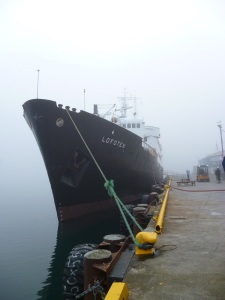
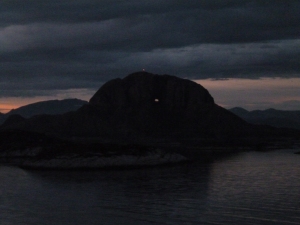
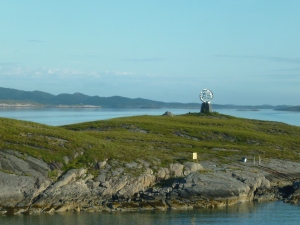
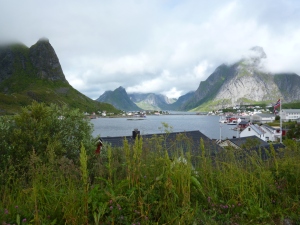
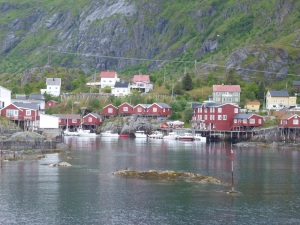
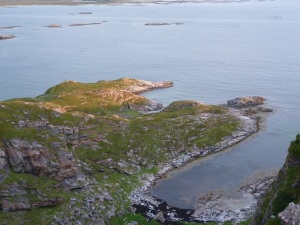
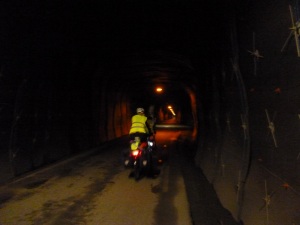
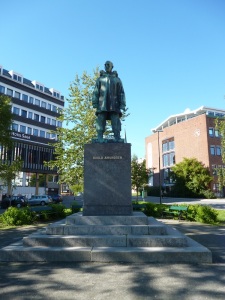
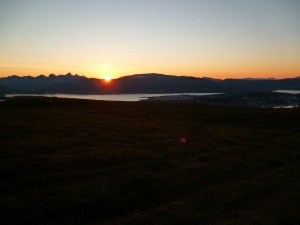
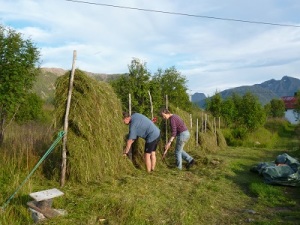
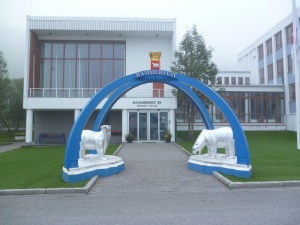
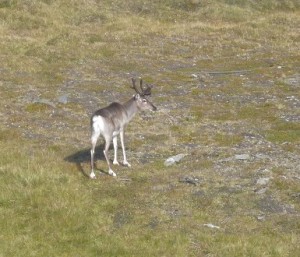
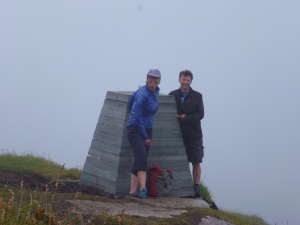
All your blogs are good but this one-with the photos-is a corker!
LikeLike